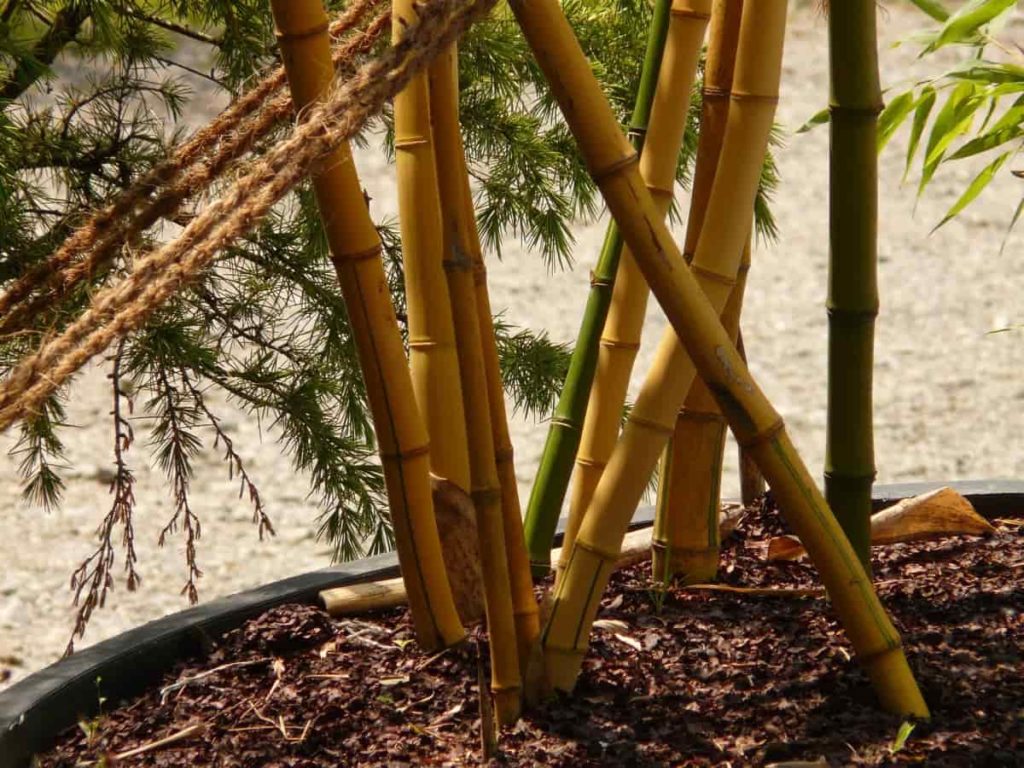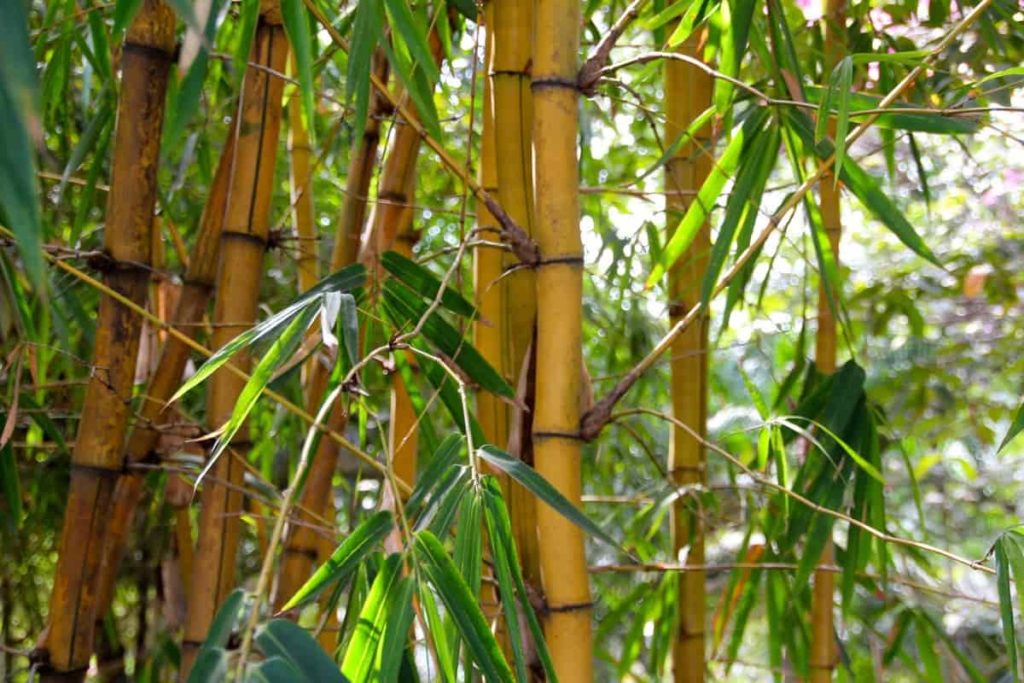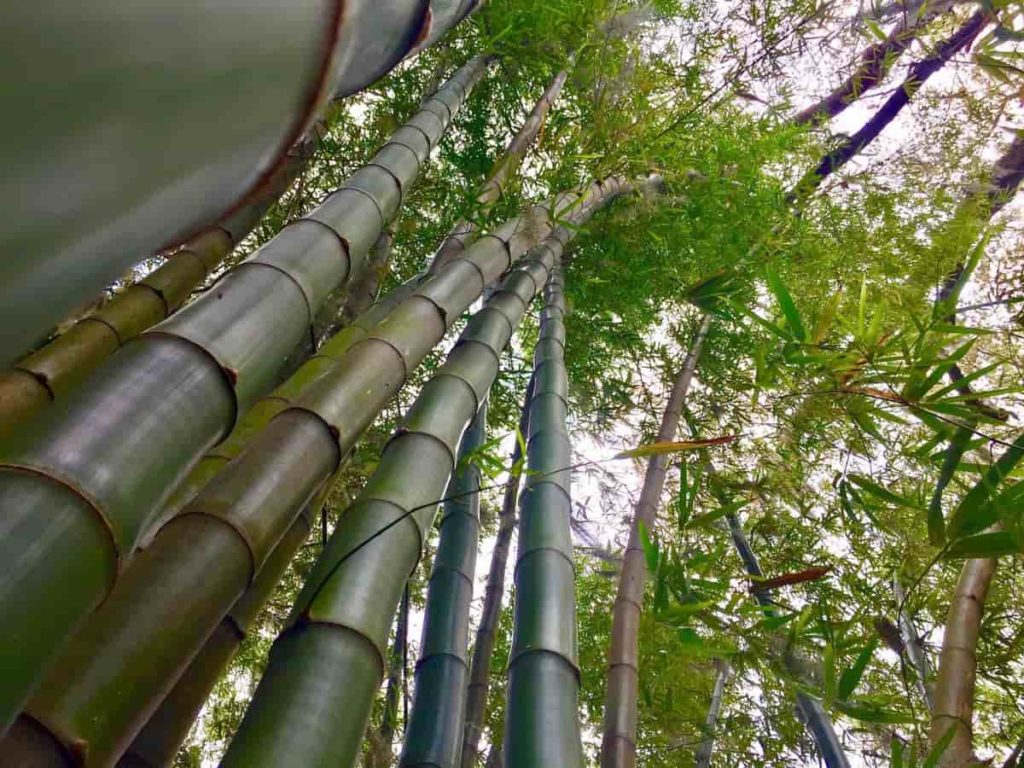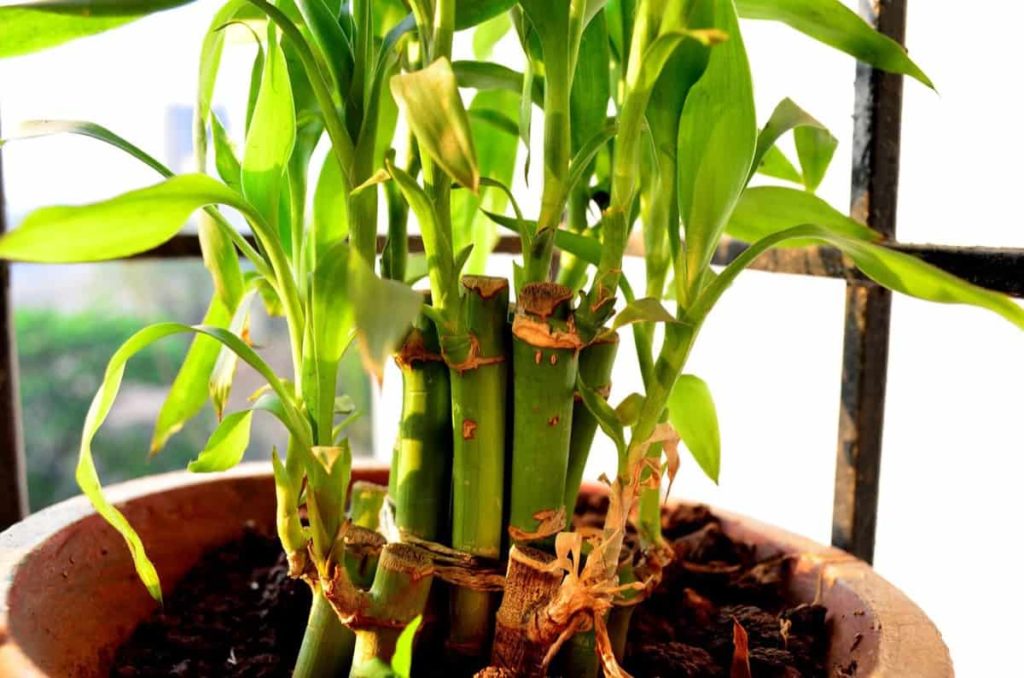Bamboo is a versatile and strong addition to the home garden. Bamboo grows fast and thick and may soon add a beautiful and lush feature to the garden in no time. Growing and maintaining Bamboo plants are easy. Whether you grow Bamboo in the ground or in containers, having a proper soil mix is the first step toward beautiful and healthy plants. Let’s check out how to prepare the soil for bamboo plants below.

Bamboo grows mostly in soil varieties, whether it is clay-based or sand. They have a very shallow root system; thus, soil type is not so important. Rather, the important thing is to feed the Bamboo on top of the soil with a good thick mulch and regular fertilizing. Most Bamboos like correctly drained soil and do not like to grow in marshy areas or areas filled with water for a long time. Good soil composition allows for proper drainage and an excellent level of nutrients.
Bamboo thrives in loamy soil. This soil combines sand, silt, and clay and maintains moisture without waterlogging. In loamy soil, the air pockets allow Bamboo roots and rhizomes to remain oxygenated; maintaining soil water prevents drought stress. It also keeps nutrients well. The loamy soil feels soft and broken to touch and is easy to work in different humidity conditions. There is no exact ratio that explains how much sand, silt, and soil it should have to be classed as loamy soil.
It can be almost equal amounts of all three. Another variation is half of sand, about 30 – 40% of the silt, and 10 – 20% of clay. Loam soil is about equal parts of sand and silt and a little less clay. Bamboo grows best from a combination of both water and soil. Bamboo needs nutritious, well-drained soil to grow successfully. Gravel, perlite, and porous materials can help improve drainage, so you should consider using them instead of organic matter like dirt.
How to prepare the soil for Bamboo plants
Soil pH for Bamboo
Bamboo usually requires moderate acidic soil, with a pH of about 6.5 to only under neutral 7. But the alkaline soil should not stop you from growing Bamboo. If you already have alkaline soil, you can modify it with sulfur to make it more acidic or choose a more versatile Bamboo.
Preparation of soil for growing Bamboo on grounds
You can improve the soil by adding manure, compost, and mushroom compost, ensuring that Bamboo starts well. Clay soil may need to be broken down with good compost or organic matter. Use dolomite or gypsum to break any particularly hardy clay soil. Very sandy soil will benefit from adding compost or heavier garden soil to improve the capacity of the land to keep water.
Fill the soil around the root ball back and then flood well with the water. Water will cause loose soil to settle around the root ball, removing any air pocket around the roots. This step is crucial. Poor backfilled soil or air pockets around the root ball can cause root balls to dry and cause stress to the Bamboo.
The soil around the plant does not need to be mounded, so plant it on the ground, leaving a little moat around it to collect water. The exception is that if the area where you are planting is wet, swampy, or heavy clay soil, mound the area around where you are planting to avoid water logging.
In case you missed it: Best Fertilizer for Bamboo: Organic, Homemade, Natural, Liquid, NPK, How and When to Apply

Preparation of soil for growing Bamboo in containers
When growing Bamboo in containers, you should use organic and inorganic elements. Soil provides good drainage but also can maintain moisture. Sand, volcanic cinders, and perlites are the best stable, inorganic ingredients. Cinders or perlites are preferred as they have a good ability to maintain moisture. Using fir bark, compost, and peat are good organic ingredients, you can increase drainage. You can also add loam or clay for micronutrients. But as a basic principle, texture takes precedence over nutrition, as nutrition can be easily supplemented.
How to grow Bamboo in poor soil
You can improve sandy and alkaline soil by adding organic materials such as compost, peat, manure, sawdust, or bark chips. This material helps in maintaining moisture, acidizing soil, and healthy plants. You can also add acid fertilizer to compensate for extreme alkaline soil. For overly acidic soil with a pH of 5.5 or less, add lime to reduce acidity to 6.0 to 7.0 pH.
Clay soil can be improved by adding sand and organic materials to provide better drainage. If submerged for weeks, most Bamboos roots are damaged. You can also improve drainage by mounding soil or planting ditches. Bamboo can be grown well in very shallow soils if proper fertility and moisture are maintained.
Soil composting for Bamboo
Working fresh compost in your Bamboo soil before planting can naturally increase nutrients by increasing drainage. Nutrients help Bamboo establish themselves and grow in their new home, and better drainage helps to waterlogs that can kill Bamboo roots. The best choices to add to your compost pile are bark shavings, grass clippings, kelp meal, and aged manure.
Prepare it with fresh ingredients three to five months before planting your Bamboo to allow green and brown elements to dissolve entirely in the compost. After adding some compost to the potting soil, plant your Bamboo and add 2 to 3 inches of manure on top of the plant and soil. Water well to settle soil and compost in the container.
Land preparation for Bamboo
You should plow the land as well and deeply as possible. Cleaning and plowing should take off at least three weeks before plantation. Adding organic materials such as compost and green manure neutralizes sawdust to help maintain moisture and nourish plants. Provide a better drainage system. Bamboo likes water and requires a lot of water to do its best, but it doesn’t like to sink into water or wet foot state.
In case you missed it: Bamboo Polyhouse Construction: Design, Subsidy, and Cost in India

Bund and Trench method
The bund and trench method involves digging trenches and heaping the dug soil to Bamboo on the bunds 1 meter wide and 50 centimeters high. The bunds and trenches should be pre-prepared to stabilize them before planting Bamboo. Bund and trench methods have several benefits.
Bamboo planted on the bunds with the soil base of the well-worked, turned upside down by trenches, will thrive. Over the next years, more soil can be dug from trenches, and piles or mounds can be planted around Bamboo clusters. Trenches can be used for irrigation and organic fertilizer preparation.
Plant Bamboo by triangular spacing
For commercial Bamboo gardens, it is recommended to plant staggered plants in triangular grids. This includes digging pits in alternate rows in the same line, the row in the middle consists of pits placed at the center point of the back row. It allows for the best exploitation of the plantation area and maximizes the distribution space available for each Bamboo cluster. It also guarantees the same distance between plant rows, which you can use for organic composting production and intercrop, and allows easy passage.
Plant Bamboo in pits
After clearing the land and digging the pits, the Bamboo plantation area should be measured and marked with sticks from the site, which will be the center of the pit. You should dig the pit wide and deep enough to have enough space in the roots of Bamboo plants and not be controlled in search of moisture and nutrients. Preparing pits before the rainy season and digging soil exposed to weather conditions is better.
A few days before planting, turn the soil into the pit. Remove competitive weeds and vegetation within 50 centimeters around the pit. For the size of a 60x 60 centimeters pit, mix the soil with about 5 kg of farmyard manure and 100 grams of urea. Nitrogen in ammonium increases water use, resulting in rapid growth. Keep the plant vertically in the pit, ensuring the roots don’t become curl.
Level the pit with mixed and rich soil. After planting, irrigate with 12 to 20 liters of water depending on the current weather conditions. This will give the necessary moisture to the rhizome and roots and suppress loose soil around the plant. Repeat the water the next day, reducing the water if necessary. If there is not enough rain for the next ten weeks, continue irrigation, initially at daily intervals, extending up to once in three days.
In case you missed it: Bamboo Planting Ideas, Methods, Tips, and Techniques

Best soil mix for Bamboo
- A light potting mixture of 1/3 Dirt, 1/3 peat moss, and 1/3 perlite will provide the best drainage and allow the soil to dry more after watering to prevent root rot. Placing a pebble under the vessel with a pebble tray or saucer under the pot will allow excess water to accumulate without soaking the roots.
- 20% composted manure is recommended for the supply of long-term nutrients and for the addition of beneficial bacteria to the mixture. Any type of composted manure is acceptable. Always use manure and not fresh manure. Different manures are not necessary, but they must be made properly composted. Then there is the biochar. The biochar absorbs proper nutrients from the soil. The biochar can be added at a rate of 5% or more for best results.
- Clay soil is rich in minerals and trace elements but needs help in aeration and drainage. The following is a very common rule of thumb; note that as heavy as your soil, add sand/lava rock and manure/humus. You can also add gypsum to help break the densest soil. You can mix 3 parts native heavy clay soil, 1 part compost or other humus, and 1 part sand or lava rock.
- Loamy soil has good aeration and drainage, but nutrients and the ability to stay moist require a lot of organic matter. So, you can mix three parts native loam soil and 1 part compost.
Natural soil amendments for Bamboo
The alternative way to feed Bamboo is compost which slowly feeds both soil and plants. Composted manure, mushroom compost, or homemade fertilizers are suitable materials. For season-long doses, spread a 1 to 2-inch layer of compost around your Bamboo plants only in spring. You may make a second application in early summer. Not only will compost feed your soil and plants, but it will also help in maintaining moisture in the soil.
In case you missed it: Indoor Bamboo Plant Care – Tips, Ideas, Secrets

You can feed your Bamboo with high nitrogen fertilizer, or if you like the organic method, use chicken manure, horse manure, or rich manure, followed by good layers of grass mulch on top. Then water it well. The best varieties of mulch are anything organic that can dissolve to enrich the soil and thus provide nutrients to Bamboo. Raking leaves around plants is a good start. Sugarcane mulch, hay, or straw are some other options.
Even green grass clippings will do the same trick if a little compost is made first, or you can spread finely around the Bamboo. Don’t worry about keeping mulch away from Bamboo trunks (as with trees); it doesn’t affect Bamboo. New shoots from the soil will find their way through the mulch layer.
What to do with soil when growing Bamboo
As an organic gardening strategy, companion plants usually combine plants that complement each other by restoring soil, repelling pests, or attracting beneficial pests. Strong Bamboo roots can break hard soil as the plant grows and expands to include beneficial microorganisms.
Bamboo roots as grass are very shallow, usually only 12 inches deep. This will make it difficult for small plants, flowers, and vegetables to compete to gain a foothold.
Bamboo makes a better companion with large shrubs and trees with deep tape roots already established. Bamboo can help by crowding out other weeds without disturbing the tree. Most varieties of Bamboo are quite fast and long. It enables them to cast some shade over your garden. If you’re growing Tomatoes and Peppers, that’s bad news. But it’s great if you have shade-loving plants, including Orchids, Bromeliads, decorative grass, or culinary herbs.
In case you missed it: Growing Bamboo Plants in Containers, Backyard, Terrace

Conclusion
Selecting the best soil for growing Bamboo is one of the most important determinants for the success or failure of a Bamboo plantation. A good selection of soil, combined with the best climate conditions, can produce stems more than 20 meters tall, or on the contrary, stems of a maximum of 6 or 7 meters high.
The right choice of soil is not only in favor of Bamboo but also in favor of the farm owner, who will see faster development of plantation, a high number of the stem, large diameter, faster production, and faster maturity. Thus, it will take less time to revive investment.
- Broccoli Seed Germination and Selection
- Asparagus Seed Germination and Variety Selection
- Seasonal Flower Gardening: Best Practices for Spring, Summer, Fall, and Winter
- How to Grow Hibiscus from Flower
- Plantation Ideas for Home Decoration: A Beginners Guide
- Flower Garden Designs and Layouts for Beginners
- Planting and Spacing Techniques in Papaya: A Beginner’s Guide
- Growing Gold: Essential Techniques for Planting Pineapples
- How to Make Kalanchoe Plant Bushy: Home Remedies and Solutions
- 11 Reasons Why Your Gardenia is Not Blooming: Home Remedies and Solutions
- Eco Elegance: The Guide to Designing a Drought-Tolerant Landscape
- Gardening on a Slope: Strategies for Hillside Landscaping
- Nourish and Flourish: Top Organic Mulches for Thriving House Plants
- Everything You Want to Know about Indian Mogra Flower: Discover Uses and Growing
- Green Thumb Success: Expert Tips for Cultivating Greenhouse Pumpkins All Year Round
- Maximize Growth & Flavor: The Ultimate Guide to Companion Planting in Herb Gardens
- How to Control Rhododendron Problems Naturally: Home Remedies and Organic Ways to Fix Them
- Natural Magic: The Remarkable Benefits of Cinnamon for Plants
- Best Steps to Revive Dying Tulip with Natural and Organic Treatment
- 10 Reasons Why Your Angel Trumpet is Not Blooming: Remedies and Treatment
- How to Fix Periwinkle Leaf and Flower-Related Problems: Natural Remedies and Solutions
- How to Fix Zinnias Leaf and Flower Problems: Discover Natural and Home Remedies
- Organic Steps to Induce Lemon Tree Flowers: A Comprehensive Guide
- Bloom Booster: Crafting the Perfect Homemade Bougainvillea Fertilizer
- Optimizing Growth: A Guide to Applying NPK Fertilizer for Potted Plants
- 10 Best Homemade Fertilizers for Rubber Plant: DIY Recipes and Application Method
- How to Boost Female Pumpkin Flowers: Effective Steps for More Flowers and High Yields
- Transform Your Indoor Garden: Top Benefits of Pink Salt for Houseplants
- 10 Best Homemade Fertilizers for Peacock Plants (Calathea): Easy DIY Guide
- Unlock Blooms: 9 Reasons Why Your Potted Chrysanthemum is Not Blooming
- 8 Reasons Why Your Potted Hibiscus is Not Blooming: Fix it with Simple Solutions
- Unlock Blooms: 9 Key Reasons Your Potted Frangipani Won’t Flower
- 10 Reasons Why Is My Ice Plant Not Blooming: Remedies and Treatment
- 10 Reasons Why My Potted Hydrangea Not Blooming: Treatment and Remedies
- 10 Reasons Why is My Wisteria Not Blooming: Remedies and Treatment
- 10 Reasons Why is My Goldfish Plant Not Blooming: Remedies and Treatment